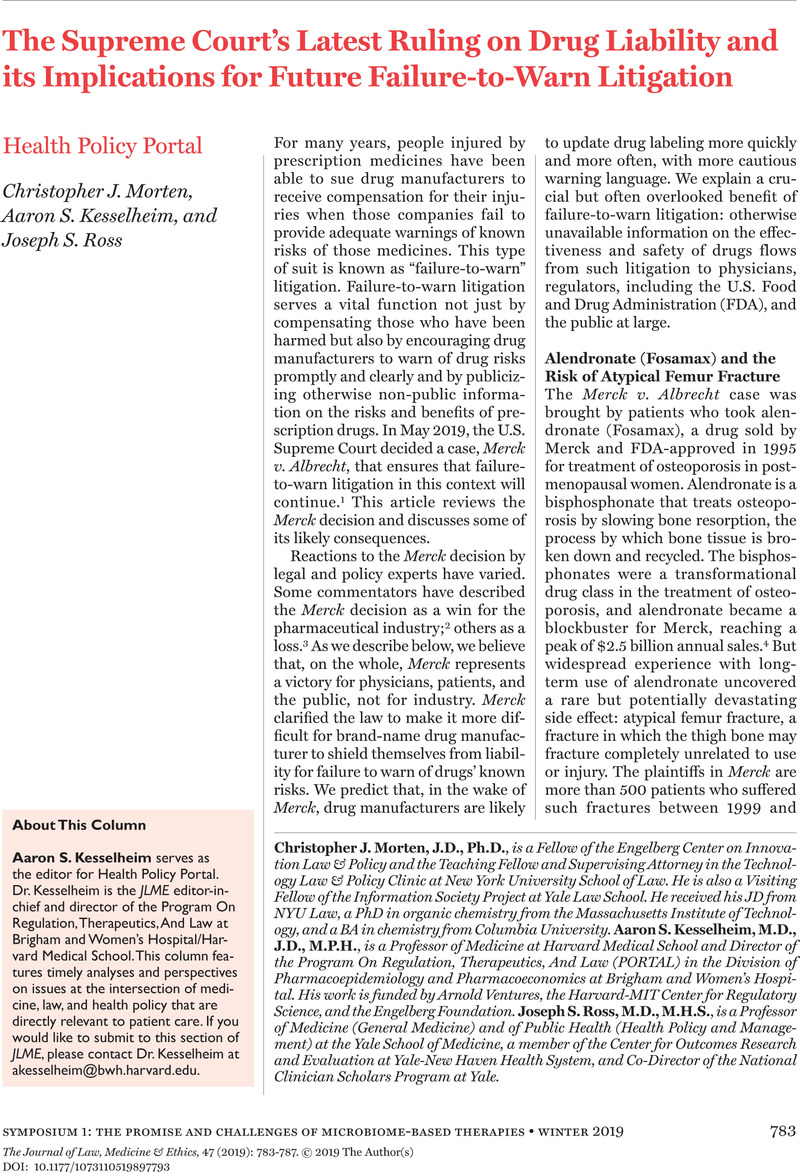No CrossRef data available.
Article contents
The Supreme Court's Latest Ruling on Drug Liability and its Implications for Future Failure-to-Warn Litigation
Published online by Cambridge University Press: 01 January 2021
Abstract
An abstract is not available for this content so a preview has been provided. Please use the Get access link above for information on how to access this content.

- Type
- Columns: Public Health and the Law
- Information
- Copyright
- Copyright © American Society of Law, Medicine and Ethics 2019
References
See, e.g., Johnston, M.C., Boumil, M.M., and Curfman, G., “A New Supreme Court Ruling on Drug Liability,” JAMA 322, no.7 (2019): 607–608; Steinberg, J., “Merck Wins New Look at Fosamax Preemption Case at SCOTUS,” Bloomberg Law, May 20, 2019, available at <https://news.bloomberglaw.com/product-liability-and-toxics-law/merck-wins-fosamax-preemption-case-at-scotus> (last visited November 19, 2019); Mauro, T., “Unusual Supreme Court Lineup Gives Merck a Win on Fosamax Litigation,” Law.com, May 20, 2019, available at <https://www.law.com/nationallawjournal/2019/05/20/unusual-supreme-court-lineup-gives-merck-a-win-on-fosamax-litigation/> (last visited November 19, 2019); Greenwald, J., “High Court Hands Win to Drugmakers in Preemption Case,” Business Insurance, May 28, 2019, available at <https://www.businessinsurance.com/article/20190528/NEWS06/912328657/High-court-hands-win-to-drugmakers-in-preemption-case> (last visited November 19, 2019).CrossRefGoogle Scholar
See, e.g., Kennerly, M., “Merck v. Albrecht: The Supreme Court Eviscerates Preemption In Branded Drug Lawsuits,” LexBlog, May 31, 2019, available at <https://www.lexblog.com/2019/05/31/merck-v-albrecht-impossibility-preemption/> (last visited November 19, 2019); Wolfman, B., “Supreme Court strongly reaffirms 2009 no-preemption decision in Wyeth v. Levine,” Public Citizen Consumer Law & Policy Blog, May 20, 2019, available at <https://pubcit.typepad.com/clpblog/2019/05/supreme-court-strongly-reaffirms-earlier-no-preemption-decision-in-wyeth-v-levine.html> (last visited November 19, 2019).Google Scholar
Neilan, T., “Merck Pulls Vioxx Painkiller From Market, and Stock Plunges,” The New York Times, September 30, 2004, available at <https://www.nytimes.com/2004/09/30/business/merck-pulls-vioxx-painkiller-from-market-and-stock-plunges.html> (last visited November 19, 2019).Google Scholar
Merck, 139 S. Ct. at 1675.Google Scholar
Id. at 1674.Google Scholar
Id. at 1678.Google Scholar
Wyeth v. Levine, 555 U.S. 555, 575 (2009).Google Scholar
Annas, G.J., “Good Law from Tragic Facts — Congress, the FDA, and preemption,” New England Journal of Medicine 361, no. 12 (2009):1206–1211.CrossRefGoogle Scholar
Wyeth, 555 U.S. at 571.Google Scholar
Merck, 139 S. Ct. at 1678 (emphasis added).Google Scholar
Id. at 1680.Google Scholar
Id. at 1679.Google Scholar
Wyeth, 555 U.S. at 570-71.Google Scholar
In our view, this central holding of the Merck decision represents a major victory for patients and a major defeat for drug manufacturers. As noted above, a separate portion of Merck decided a procedural issue: should the question of whether preemption applies in a given case be decided by a judge or a jury? Merck held that the question should be decided by a judge, not a jury. Merck, 139 S. Ct. at 1680. This outcome permits judges to dismiss some failure-to-warn lawsuits prior to trial, and it may favor industry to the extent that juries are more likely than judges to side with a sympathetic plaintiff. However, we believe the import of Merck's central holding on the legal standard for preemption outweighs the import of the procedural judge-versus-jury question, and we therefore disagree that Merck represents a victory for industry, on the whole.Google Scholar
21 C.F.R. § 314.70(c).Google Scholar
Merck, 139 S. Ct. at 1673. 21 C.F.R. § 314.70(c) sets the 30 day deadline for FDA review of CBE labeling changes.Google Scholar
Dusetzina, S.B., Higashi, A.S., Dorsey, E.R., Conti, R., Huskamp, H.A., Zhu, S., Garfield, C.F., and Alexander, G.C., “Impact of FDA Drug Risk Communications on Health Care Utilization and Health Behaviors: A Systematic Review,” Medical Care 50, no. 6 (2012): 466–478.CrossRefGoogle Scholar
Kesselheim, A.S., Darby, D.L., Studdert, D.M., Glynn, R.J., Levin, R.L., and Avorn, J., “False Claims Act Prosecution Did Not Deter Off-label Drug Use in the Case of Neurontin,” Health Affairs 30, no. 12 (2011): 2318–2327.CrossRefGoogle Scholar
Egilman, A.C., Kesselheim, A.S., Krumholz, H.M., Ross, J.S., Kim, J., and Kapczynski, A., “Confidentiality Orders and Public Interest in Drug and Medical Device Litigation,” JAMA Internal Medicine, published online October 28, 2019. doi: https://doi.org/10.1001/jamainternmed.2019.5161.CrossRefGoogle Scholar
Krumholz, H.M., Ross, J.S., Presler, A.H., and Egilman, D.S., “What Have We Learnt from Vioxx?” BMJ 334 (2007): 120–123.CrossRefGoogle Scholar
Jureidini, J.N., McHenry, L.B., and Mansfield, P.R., “Clinical Trials and Drug Promotion: Selective Reporting of Study 329,” International Journal of Risk & Safety in Medicine 20 (2008): 73–81.CrossRefGoogle Scholar
Downing, N.S., Aminawung, J.A., Shah, N.D., Krumholz, H.M., and Ross, J.S., “Clinical Trial Evidence Supporting FDA Approval of Novel Therapeutic Agents, 2005-2012,” JAMA 311, no. 4 (2014): 368–377; Kesselheim, A.S., Wang, B., Franklin, J. M, and Darrow, J.J., “Trends in Utilization of FDA Expedited Drug Development and Approval Programs, 1987-2014: Cohort Study,” BMJ 351 (2015): h4633.CrossRefGoogle Scholar
Downing, N.S., Shah, N.D., Aminawung, J.A., Pease, A.M., Zeitoun, J.-D., Krumholz, H.M., and Ross, J.S., “Postmarket Safety Events Among Novel Therapeutics Approved by the US Food and Drug Administration Between 2001 and 2010,” JAMA 317, no. 18 (2017): 1854–1863.CrossRefGoogle Scholar
Pinnow, E., Amr, S., Bentzen, S.M., Brajovic, S., Hungerford, L., St. George, D.M., and Dal Pan, G., “Postmarket Safety Outcomes for New Molecular Entity (NME) Drugs Approved by the Food and Drug Administration Between 2002 and 2014,” Clinical Pharmacology & Therapeutics, 104, no. 2 (2017): 390–400.CrossRefGoogle Scholar
FDA, Step 5: FDA Post-Marketing Drug Safety Monitoring, Jan. 4, 2018, available at <https://www.fda.gov/ForPatients/Approvals/Drugs/ucm405579.htm> (last visited November 19, 2019).+(last+visited+November+19,+2019).>Google Scholar
See PLIVA, Inc. v. Mensing, 564 U.S. 604 (2011).Google Scholar
Association for Accessible Medicines, 2018 Generic Drug Access & Savings Report, available at <https://accessiblemeds.org/resources/blog/2018-generic-drug-access-and-savings-report> (last visited November 19, 2019).+(last+visited+November+19,+2019).>Google Scholar
For a recent court decision, see In re Zimmer (Nexgen Knee Implant Products Liability Litigation), 884 F.3d 746 (7th Cir. 2018).Google Scholar
Avorn, J. and Shrank, W., “Highlights and a Hidden Hazard — the FDA's New Labeling Regulations,” New England Journal of Medicine 354, no. 23 (2006): 2409–2411.CrossRefGoogle Scholar




